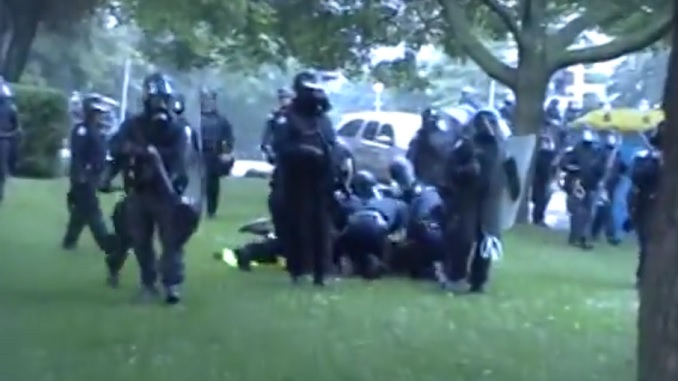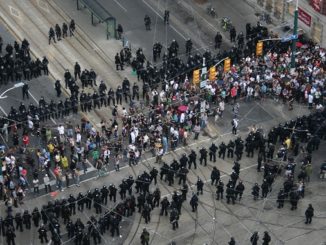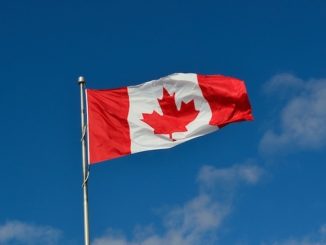The following article was written by Elliot Coombe, a Toronto resident whose never-before-seen video captured firsthand the brutality of the G20 Toronto protest suppression and led to the only charges laid against an officer from the entire event. His experiences opened his eyes to a Canada and a Toronto unlike any he’d encountered before – and his story and video recording may do the same for you. Be warned that this article and video contain depictions of physical violence and police brutality. The video has been included at the bottom of the article.

In the immediate aftermath of the G20 Toronto, it was hard to make sense of what had just happened. I remember sitting in a bar with some coworkers, minutes after a confrontation with police, and watching my hands shake as I came to a deep and visceral understanding. Born in Toronto but having spent much of my time growing up in a country where protesting the government will land you in jail, I have always been thankful for the rights and freedoms that we enjoy. In a city as diverse and cosmopolitan as Toronto, you don’t need to look far to find people who have suffered under oppressive and violent governments around the world. It’s an experience that instills a deep appreciation for the values and laws that underpin our free society and is at the core of our love for this city and this country.
It’s that love of country and community that motivated tens of thousands of us to go to a peaceful G20 march organized by a coalition of groups including teachers unions and environmental nonprofits. We simply wanted to practice democracy by exercising our inalienable right to speak out against the government. It is a right that is protected by law and a fundamental cornerstone of any free democracy. But sadly, it is also a right that many take for granted.
I remember the day vividly. I was a UofT Poli Sci nerd and carried a sign that said “Infrastructure Investment Not Structural Adjustment”, a reference to IMF lending policies, precisely the sort of macroeconomic policy that gets discussed at conferences like the G20. And I had a pocket camcorder with me, a birthday gift from my grandmother, that I was using to document the day.
After the march, my friends and I returned to the “designated free speech zone” for protesters at Queen’s Park. It was many kilometres away from the perimeter fence around the meeting itself and a refuge for those wanting to avoid the chaos happening downtown. But after the images of a burning police car spread across the major news channels, something quickly changed.
Seemingly in the blink of an eye, hundreds of police in riot gear arrived at Queen’s Park (where there had been zero violence or vandalism). I stood near the front of the crowd of protesters chanting “We Are Peaceful, How Bout You?” to a line of police that was forming in front of us. Suddenly, and without warning, a group of police burst out from behind their line, sprinting towards a man who had been standing around, holding a sign. I pulled out my camcorder and started rolling just as a swarm of cops pinned him to the ground. Seconds later, one of the officers took out his baton and started beating the man on the ground. Zooming in on his muscular arms and black nightstick, I captured this obviously unnecessary and seemingly malicious attack against a man who had done literally nothing but exercise his democratic rights. Rising from a crouching position, the officer wasn’t wearing his name tag or badge number but as he took a moment to yell at the crowd, his visor was up and so the camera captured a clear image of his face.
Over the next 12 minutes, I kept the camera rolling, intent on capturing what felt like (and was later confirmed by the courts to be) an egregious and illegal trampling of our fundamental democratic rights. For those of us who were there, we could see that what the police were doing was illegal. But more importantly, we knew that we were bearing witness to one of those moments in history when democracy and the rule of law get sidestepped by the oppressive tactics of a government that wants to silence and discredit dissent. “The Whole World is Watching”, the crowd chanted as the police advanced on us.
In the end, I was fortunate. I wasn’t arrested. I wasn’t beaten. And I was able to leave the area with my camera intact. Later, sitting quietly in a Bloor St. bar while watching my hands shake, I recalled that an officer had pointed a grenade launcher at my face (probably filled with non-lethal bean bags but that’s hard to recall when you’re literally staring down the barrel of a gun) and reflected on my lifelong assumption that Canada is a place where the police won’t beat you for speaking out against the government. Had we, a bunch of global governance Poli Sci dorks, done something to deserve this treatment? Had the violent suppression tactics used against us been warranted by our desire for greater transparency in IGOs? Were we enemies of the state? Or were the police? What had happened to the Canada I thought I knew?
In the months that followed, the shock of the experience gave way to a slowly encroaching sense of dread that they had gotten away with it. Public sentiment was on the side of the police and only a handful of local media were strongly pursuing justice. It became easy to tell who had been there to witness the truth and who was only going off the dramatic clips of the black bloc.
One of those pursuing the truth was Rosie DiManno, the Toronto Star reporter who was covering the story of Adam Nobody, a peaceful protester who had been hospitalized after a particularly violent arrest. Chief Bill Blair had accused him of being a violent criminal and suggested video of the incident had been doctored (he would later retract these statements and apologize). Months after the G20, I was reading one of DiManno’s articles and clicked play on a video. What I saw was immediately familiar as the same incident I had filmed.
Upon realizing that I had footage that would be relevant to the case, I contacted The Star and arranged to meet with DiManno and an editor at their headquarters downtown. Arriving with the camera my grandmother had given me, they watched the footage and we came to an agreement- The Star could have the video and all I asked was that they protect my anonymity. The truth is I was scared. I had seen, with my own eyes, the anger and violence that this officer was capable of. I knew that somewhere, he was walking around with a gun and a badge, part of a fraternal order of police that protects and serves themselves first and us second. I was afraid for my life.
For the next four days, the front page of the Star would carry stills from my video, alongside headlines like “What Now, Chief Blair?”. Having shut down the investigation on the grounds that none of the officers could be identified, the new video showing his face was a game changer. I was soon contacted by The Star, saying that the Special Investigations Unit and Office of the Independent Police Review Director had reached out to them in hopes of interviewing me. Requesting the same anonymity the Star had promised, I agreed to provide the raw file of my video and speak with investigators. A few days later, the SIU arranged to interview me in an unmarked white van outside my work. Sitting in the backseat of that van, with SIU investigators who understood the seriousness of being a witness against the police, I felt vaguely comforted by their protection while simultaneously wondering if I would be murdered by the police for all of this.
In the months that followed, I began to have recurring nightmares about the officer. In them, he’d show up at my home drunk and angry. He had lost his job, his wife, his family, he had spiralled into alcoholism and blamed my video for everything. He still had a gun and he still wore that same expression on his face that I saw at the G20. The nightmares still happen.
The officer was charged with assault and his case prepared to go to trial, investigators brought me in to give numerous statements detailing what I had seen. Eventually I was told I would be a witness for the prosecution. I spent two days sitting on a bench in the hall outside the courtroom, waiting to be called to the stand. It was the first time I had seen the officer in person since the G20 and at that point my name was in the court records so he finally had a face and a name for the person who had exposed his misdeeds.
In the end, I was excused from having to testify. Apparently, my various witness statements had been so fair and reasonable to the officer that they didn’t want to cross-examine me the way they had with John Bridge, who had taken the first video and whose credibility was aggressively attacked on the stand.
So I went home. And I waited. For years.
The officer, convicted of assault, was sentenced to 45 days in jail but he successfully appealed. Then the sentence was changed to docking 5 days pay but he has appealed again. The case, still going after 7 years, is now coming down to whether he should be punished at all or whether the stress and inconvenience of the experience is punishment enough.
It is not enough. With every fibre of my being filled with rage and pain, it is not enough.
Canada is not a police state. We allow dissent. This may seem like an obvious platitude but on that weekend, a police state was in effect and dissent was brutally suppressed. The people who ordered the crackdown have not been punished and the people who executed the crackdown have not been punished. There was no justice.
When politicians talk about curtailing our Charter rights as “balancing security and freedoms”, I often wonder if, for them, this is all just some hypothetical academic debate. Obsessed with swaddling us in an illusion of security in the post 9/11 world, they ignore the real-world practical consequences of playing fast and loose with our most basic freedoms. The real threat of things like Bill C-51 isn’t that it’ll be abused some day in the future but that it has a real and tangible impact on civil society today and every day it is in effect. Mass domestic surveillance is a frightening thing and has a chilling effect on community activist organizations. Likewise, when police regularly infiltrate peaceful activist planning groups, it sows suspicion and fear amongst those who are fighting to make our country even greater.
What then, is the lesson we’re supposed to take from the G20 experience? That the government can spend a billion dollars of our tax money to brutalize us and we’re just supposed to take it? That our fundamental democratic right to dissent is contingent on everyone behaving? That the rule of law does not apply to the police? (Old news for marginalized communities)
Democracy is not a passive activity. Defending our rights and freedoms requires constant vigilance, especially in times like these. So when politicians like Stephen Harper and Justin Trudeau speak of “Balancing Freedom and Security”, they’re accepting the violability of Charter Rights and Freedoms for the sake of security. And in so doing, they are destroying with legislation what terrorists could never destroy with bombs or bullets- the very fabric of our democracy.
Luckily for the future, the G20 radicalized an entire generation of Torontonians. You can’t make us sing “We Stand on Guard For Thee” every morning as kids and not expect us to show up when it counts. And that’s what we need now, from YOU.
If you care about the future of democracy in Canada, here are three things you can do right now to send a message to Ottawa-
- Contact your MP with this easy tool from Open Media
- Volunteer or donate to Samara Canada
- Tell Bill Blair to go f*ck himself-
- Bill.Blair@parl.gc.ca
- 613-995-0284
- 416-261-8613
- https://twitter.com/BillBlair
***
“Those who make peaceful revolution impossible will make violent revolution inevitable.”
-John F. Kennedy
Embedded below is Elliot’s video of the G20 Toronto protests, which was critical evidence in the prosecution case that led to assault charges being filed and a conviction (still under appeal seven years later). No other officer has been held accountable for protest suppression, and the person in charge of the operation is now a Liberal MP. Watch the video, and then take action following some or all of the steps suggested by Elliot above.




